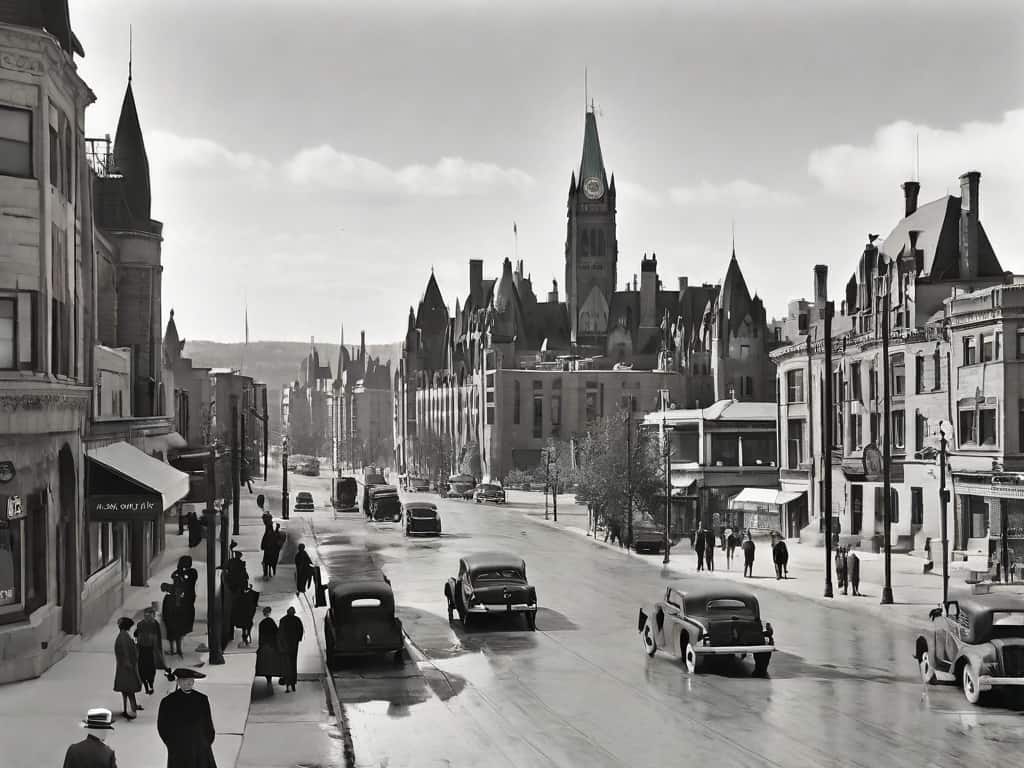In recent years, Ottawa, has witnessed a significant surge in its rental market, a trend that has left many residents grappling with the reality of steep housing costs. This phenomenon is not merely a matter of numbers on a lease agreement; it has profound implications for the quality of life and affordability in this historically rich city. As the heart of Canadian politics and a hub for tech and academic pursuits, Ottawa attracts a diverse array of individuals, each seeking a place to call home within its picturesque neighborhoods. However, the rising rent has raised pressing questions about the sustainability and accessibility of living in Ottawa. We will dive into the multifaceted reasons behind this upward trend. From historical shifts to economic forces and government policies, we will explore the various elements that contribute to Ottawa’s expensive rental market, offering a comprehensive understanding of this complex issue.
Historical Perspective

Ottawa’s rental market has not always been as daunting as it is today. To understand the current state, it’s essential to look back at the city’s housing history, which reveals a gradual yet significant transformation.
The Early Years: In the early 20th century, Ottawa was a modest government town, with a relatively stable housing market. Rental prices were moderate, reflecting the city’s then-small size and lower cost of living. The post-war era, particularly the 1950s and 1960s, saw a boom in housing development, catering to the influx of government workers. However, these developments were primarily suburban, single-family homes, setting a precedent that would later impact the rental market.
The Shift in the Late 20th Century: As Ottawa expanded, the focus on single-family homes led to a shortage in multifamily housing units. The 1980s and 1990s saw a gradual increase in rental prices, driven by the city’s growth in government and tech sectors. This period marked the beginning of a shift, with rental prices starting to climb steadily.

The 21st Century Acceleration: The turn of the millennium marked a significant acceleration in rental costs. The tech boom, coupled with Ottawa’s growing reputation as a desirable place to live, led to an influx of high-income professionals. The demand for housing began to outpace supply, particularly in the city center and popular neighborhoods, pushing rental prices upward.
Recent Years: The last decade has seen the most dramatic increase. Factors like urbanization, increased immigration, and a surge in university student populations have further strained the already limited rental inventory. Additionally, the rise of short-term rental platforms has diverted a portion of potential long-term rental properties, exacerbating the issue.
Through this historical lens, it becomes evident that Ottawa’s rental market has evolved from a once-moderate landscape to its current state, influenced by various socio-economic shifts and housing policies. The roots of today’s high rents can be traced back through these decades of change, laying the groundwork for the economic factors that we will explore in the next section.
Economic Factors
The economic landscape of Ottawa plays a crucial role in shaping its rental market. By dissecting the economic factors, we can gain a clearer understanding of why rents have soared in recent years.
High Demand and Limited Supply: The most fundamental economic principle affecting Ottawa’s rental market is the imbalance between demand and supply. With a steady influx of professionals, students, and immigrants, the demand for housing has consistently outstripped the supply. This imbalance is further amplified by the city’s limited geographical expansion options, constrained by natural boundaries like the Ottawa River and the Greenbelt, a protected area of green space.

Income Levels and Employment Rates: Ottawa boasts one of the highest average incomes among Canadian cities, largely due to its concentration of government and high-tech jobs. While this might suggest greater affordability, the reality is that high incomes have contributed to an upward pressure on rental prices, as landlords adjust prices in line with what the market can bear.
Impact of the High-Tech Industry: The burgeoning high-tech industry, centered in areas like Kanata, has brought an influx of highly paid professionals to Ottawa. This demographic shift has led to a rise in luxury rentals and condominium developments, skewing the market towards higher-end offerings and driving up average rents.

Interest Rates and Real Estate Investment: Fluctuations in interest rates also influence the rental market. Lower interest rates in recent years have led to increased real estate investment, with investors buying properties to rent out, often at higher prices to ensure a return on investment.
Cost of Living and Inflation: Ottawa’s overall cost of living, including utilities, transportation, and groceries, has seen a steady rise, paralleling the increase in rental costs. Inflation affects landlords’ operating costs, which are often passed on to tenants in the form of higher rents.
In summary, the economic factors contributing to Ottawa’s expensive rental market are multifaceted, involving a complex interplay of market dynamics, income levels, industry growth, investment trends, and general cost of living considerations. Understanding these elements provides a foundation for exploring how government policies and regulations impact rental prices, which we will discuss in the next section.
Government Policies and Regulations
Government intervention and regulatory frameworks have a significant impact on the rental market. In Ottawa, several policies and regulations have contributed to the current state of high rental costs.
Zoning Laws and Development Restrictions: Ottawa’s zoning laws and development restrictions play a critical role in determining where and what type of housing can be built. These regulations, often designed to preserve the character of neighborhoods or protect green spaces, can limit the construction of new rental properties, exacerbating the supply shortage.
Rent Control and Tenant Protection Laws: While rent control aims to protect tenants from sudden, steep rent increases, it can have unintended consequences. In Ottawa, rent control applies to buildings constructed before November 15, 2018. This policy can discourage landlords from investing in or maintaining older properties and can lead to a scarcity of well-maintained rental units, pushing tenants towards newer, more expensive options.
Property Taxes and Utility Costs: High property taxes and utility costs in Ottawa can indirectly affect rental prices. Landlords often pass these costs onto tenants, contributing to higher overall rental rates. This is particularly true for multi-residential properties, which can face higher tax rates than single-family homes.
Housing Policies and Affordable Housing Initiatives: The government’s efforts to increase affordable housing can impact the rental market. Programs that incentivize the development of affordable housing units are crucial, but the pace and scale of these initiatives often lag behind the growing demand, especially in fast-growing cities like Ottawa.

Impact of Short-Term Rentals: Regulations surrounding short-term rental platforms like Airbnb have also influenced Ottawa’s rental market. These platforms can reduce the number of available long-term rental properties, as homeowners opt for the potentially higher income from short-term rentals. The city’s efforts to regulate these platforms can, therefore, have a significant impact on the availability and pricing of long-term rentals.
Government policies and regulations in Ottawa are a double-edged sword: while they aim to protect certain interests and tenants, they also contribute to the complexities of the rental market, influencing the supply, quality, and pricing of rental units.
Comparative Analysis with Other Cities
To put Ottawa’s rental market into perspective, it’s insightful to compare it with other major Canadian cities. This comparison helps to understand whether Ottawa’s rental issues are unique or part of a broader national trend.
Toronto and Vancouver: The Pricier Counterparts: Toronto and Vancouver are often cited as having the most expensive rental markets in Canada. Compared to these cities, Ottawa’s rental prices are lower, but the gap has been narrowing. While Toronto and Vancouver have long been known for their high cost of living, Ottawa’s recent spike in rental prices indicates a similar trend, albeit at a different scale.
Montreal: A Different Market Dynamics: Montreal presents a contrasting scenario. Traditionally known for more affordable rents, Montreal’s rental market operates under a different set of regulations and cultural norms, including a higher prevalence of rent-controlled units. This has kept rental prices comparatively lower than in Ottawa, despite both cities having robust student and immigrant populations.
Calgary and Edmonton: The Resource-Driven Markets: Calgary and Edmonton, driven largely by the energy sector, have experienced different rental market fluctuations. These cities have seen periods of both rapid increases and decreases in rental prices, influenced heavily by the health of the oil and gas industry. Ottawa’s market, less tied to such a volatile sector, has shown a more consistent upward trend.
Smaller Cities and Regional Differences: Smaller cities and towns across Canada often have significantly lower rental prices compared to Ottawa. However, they also tend to have fewer job opportunities, especially in specialized sectors like government and high-tech, which are abundant in Ottawa.
This comparative analysis underscores that while Ottawa’s rising rental costs are part of a broader national trend, they are also influenced by unique local factors. The city’s status as the capital, its steady job market, and its appeal as a place to live have contributed to its rental market becoming increasingly comparable to Canada’s most expensive cities.

From a historical perspective, we’ve seen how Ottawa evolved from a modest government town to a bustling city with a high demand for rental properties. Economic factors, including the imbalance between demand and supply, high average incomes, and the influence of the high-tech industry, have significantly driven up rental costs. Government policies and regulations, while well-intentioned, have often contributed to the complexity and challenges of the housing market. Moreover, our comparative analysis with other Canadian cities reveals that Ottawa’s situation, while unique in some aspects, mirrors a national trend of urban housing affordability challenges.
The insights gleaned from this exploration are crucial for both potential renters and policymakers. For renters, understanding these dynamics can aid in making informed decisions about where and how to live in Ottawa. For policymakers, this analysis highlights the areas needing attention and potential policy adjustments to address the affordability crisis.
The reasons behind Ottawa’s expensive rental market are deeply rooted in historical, economic, and regulatory factors, each interplaying to shape the current scenario. As the city continues to grow and evolve, addressing these challenges will be key to ensuring that Ottawa remains an accessible and desirable place to live for all its residents.
